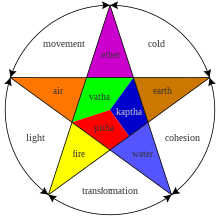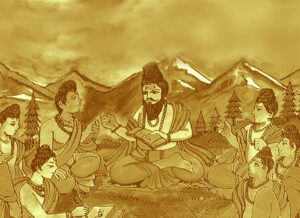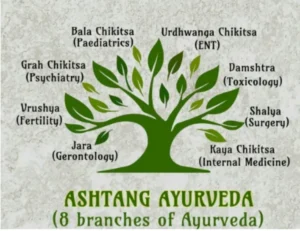Ayurveda means “The Science of Life”, which is considered to be the oldest healing science originated in India more than 5,000 years ago. It is often called the “Mother of All Healing.” It stems from the ancient Vedic culture and was taught for many thousands of years in an oral tradition from accomplished masters to their disciples. The principles of many of the natural healing systems now familiar in the West have their roots in Ayurveda, including Homeopathy and Polarity Therapy.

According to Ayurveda, the human body is composed of tissues (dhatus), waste (malas), and biomaterials (doshas). The seven dhatus are plasma (rasa), blood (rakta), muscles (māmsa), fat (meda), bone (asthi), marrow (majja), and semen (shukra). The three elemental bodily humors, the doshas or tridosha, are vata (space or air, equated with the nervous system), pitta (fire, equated with enzymes), and kapha (earth and water, equated with mucus). A parallel set of mental doshas termed satogun, rajogun, and tamogun control psychology. Each dosha has particular attributes and roles within the body and mind; the natural predominance of one or more doshas thus explains a person’s physical constitution (prakriti) and personality. Ayurvedic tradition holds that imbalance among the bodily and mental doshas is a major etiologic component of the disease. One Ayurvedic view is that the doshas are balanced when they are equal to each other, while another view is that each human possesses a unique combination of the doshas which define this person’s temperament and characteristics. In either case, it says that each person should modulate their behavior or environment to increase or decrease the doshas and maintain their natural state.
Ayurveda is a Sanskrit term, composed two words “Ayur” and “Veda”. Ayur means life and Veda means knowledge, science, and study. Combining these two different words together we can say Ayurveda is the study of life, knowledge of life, or science of life. Simply put, Ayurveda is everything about life. Our life begins from our date of birth and ends at death. The question of life is all about: How to have a healthy, joyful, and balanced lifestyle during our life span? Ayurvedic knowledge provides the answer.
“Ayurveda is the knowledge of a happy and unhappy life, a good and bad life, and that which contributes to those four aspects. “ —Charaka
Ayurveda is a way of living. It’s about being healthy from moment to moment. As you wake up in the morning, as you eat your meals, as you schedule a time for exercise and play, Ayurveda teaches you to consider what nourishes your mind, body, and spirit.
What you eat, what you watch on Netflix, how much time you spend exchanging the energy of love with others—everything you do, say, think, and feel has an impact on your body, mind, and energy system.
Each moment you make a choice. You can choose to do something that helps create balance in yourself or that may bring you out of balance.
Ayurveda gives you knowledge about yourself and your relationship to the external world so that you can make informed choices each moment, each meal, each day, and each season.
Objectives of Ayurveda

As a holistic practice, Ayurveda creates overall wellbeing and health, recognizing that body, mind, and spirit are interrelated. So, its objectives are two-fold:
- Swasthasya Swathya Rakshanam – To bring you into balance protect and maintain the health of a healthy person (Prevention is better than cure)
- Aturasya Vikar Prashamanam – To alleviate the discomfort and giving relief to sick people (Therapeutics)
Branches of Ayurveda
Ayurveda is a complete medical system. It treats the whole person as an integrated being: body, mind, and spirit. Ayurveda is a comprehensive medical system. It includes eight branches. These are:

- Kaaya Chikitsa (Internal Medicine)
- Baala Chikitsa (Treatment of Children/Pediatrics)
- Graha Chikitsa (Microbiology/Psychology)
- Shalakya Chikitsa (Treatment of disease above the clavicle/ENT)
- Shalya Chikitsa (Surgery)
- Agad tantra (Toxicology)
- Jara Chikitsa (Geriatrics, Rejuvenation)
- Vrsha Chikitsa (Aphrodisiac therapy)
The following therapies are among those, which your Ayurvedic practitioner may recommend. These therapies are all natural, have been used for thousands of years, and are used to restore your body by helping to circulate blood and lymph, support digestion, and boost immunity.
5 Divine therapies of Ayurveda
- VAMANA: Vamana cleanses the accumulated Kapha, and purifies the upper digestive tract and respiratory system.
- VIRECHANAM: The procedure in which the orally administered drug act on internally situated doshas, especially pitta.
- BASTI: Bastis a prime treatment modality among panchakarma. Here medicine is administered by anal route.
- RAKTHA MOSKSHANA: It is a unique para-surgical measure which eliminates the toxins present in blood. It Purifies the blood
- NASYA: Elimination of toxins through the gateway of head, i.e., Nose. The nasal inhalation of medicines.
THERAPIES USED IN AYURVEDA
- Panchakarma: a fivefold detoxification treatment involving massage, herbal therapy, and other procedures.
- Herbal supplements: ingesting natural, whole herbs and spices in powder, liquid, or capsule form to enhance the body’s ability to detoxify, absorb nutrients, and regain equilibrium
- Bodywork: massaging herbalized oil over the entire body in rhythmic strokes
- Marma therapy: applying pressure to specific points on the body to help energy flow
- Diet and lifestyle approach: to prevent disease as well as gaining quick relief from the disease
- Mindfulness practice: becoming aware of what you are.
Experiencing in each moment, which allows digestion, sleep, and other important physical and mental functions to occur naturally and easefully
- Yoga, Meditation, and Pranayama: cultivating mental equilibrium; promoting energy flow throughout the body, and enhancing physical strength, stamina, and health
- Healing modalities with metals, gemstones, aromas, and colors: using the energetic vibration of metals, gemstones, aroma, and colors to positively affect your energy system and overall health
Ayurvedic Treatment
An Ayurvedic doctor will create a treatment plan specifically designed for each individual after taking into consideration a person’s unique physical and emotional makeup, primary life force, and the balance between all three of these elements (Doshas). The goal of treatment is to cleanse your body which leads to your illness. The cleansing process—called “panchakarma”— is designed to reduce your symptoms and restore harmony and balance.
Need an expert advice on your health matters?
Our Expert Doctors are at your service. Book an appointment now.!!!

